#OBD scanner
Explore tagged Tumblr posts
Text
Automax Tools Ramadan Sale Limited Time Only Shop Now
Want to upgrade your garage or at the right place?
After rooming for various distributors around India you came to the right place where you get the original product for the vehicle.
Let me introduce you to Automax Tools an authorised distributor for Gscan and Topdon in India.
The Automax tools have various advanced products that upgrade your garage.
Automax tools also provide 24*7 support services to more than 10,000 happy customers all around India.
For us you are not a customer you all are family.
The list of products Automax tools sell are:-
V2200 plus :
The V2200Plus is a 2-in-1 jump pack and battery tester that takes on the unexpected. Offering up to 35 jumps on a full charge, smart clamps to protect against common safety hazards, and features a 300-lumen LED light. A built-in Bluetooth module supports 12V battery tests by pairing an app with Bluetooth. The V2200Plus is a 2-in-1 jump pack and battery tester that takes on the unexpected. Offering up to 35 jumps on a full charge, smart clamps to protect against common safety hazards, and features a 300-lumen LED light. A built-in Bluetooth module supports 12V battery tests by pairing an app with Bluetooth.

JS3000 :
The JumpSurge3000 is a 3000 Peak Amp jumpstarting tool and power bank for vehicles on and off the road. This device supports vehicles with 12V batteries on up to 9L gas engines and 7L Diesel engines. Capable of 45 jump starts on a single charge, the JumpSurge3000 is a robust and powerful tool capable of bringing a battery “back to life” in only 1 second. It's multiple protection systems and fast charging capability keep you ready for anything, no matter where you go or what you drive.

GScan Zenith Z5:
Introducing our first automotive diagnostic scan tool in the Z series.
Combined with our vast diagnostics software and the world's best industrial tablet, Z5 will give you diagnostic confidence.
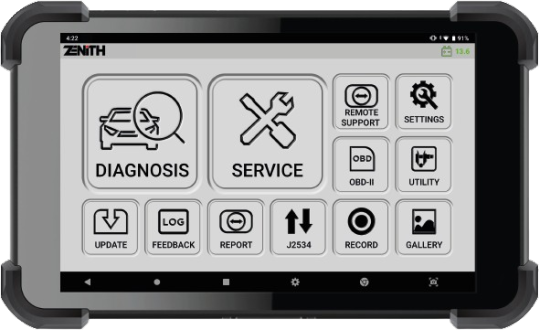
Tornado 90000:
The Tornado90000 is TOPDON's newest cutting-edge smart charger, made for professional and commercial users. This device is suitable for all types of 12V and 24V lead-acid and lithium batteries, with a wide battery capacity range from 5 to 90 amps.

Jaltest V9:
Jaltest V9 is the module of Jaltest Diagnostics multi-brand and multi-system diagnostics tool designed to meet the most demanding workshop needs. It enables carrying out the most advanced diagnostics tasks for the repair and maintenance of commercial vehicles such as trucks, buses, trailers, light commercial vehicles, and pick-up trucks.
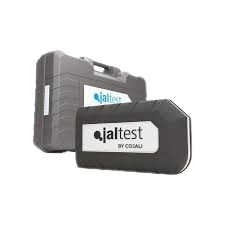
BT200:
TOPDON’s BT200 is an automotive battery tester perfect for new users, with easy plug-and-play operation, and an accurate display of test results. The tests will help users assess whether the battery needs to be replaced.
The tool is suitable for battery testing 12V with up to 2000 Cold Cranking Amps (CCA), cranking testing, and charging testing 12V&24V batteries. It can test Regular Flooded, AGM, GEL, EFB, and VRLA batteries. Test results are based on CCA, DIN, JIS, EN, IEC, GB, SAE, MCA, BCI, and CA Standards.

BT300:
TOPDON®’s BT300P is our newest 12V lead-acid vehicle battery tester with a Built-in Printer. It can test 100 to 2000 Cold Cranking Amps (CCA) batteries
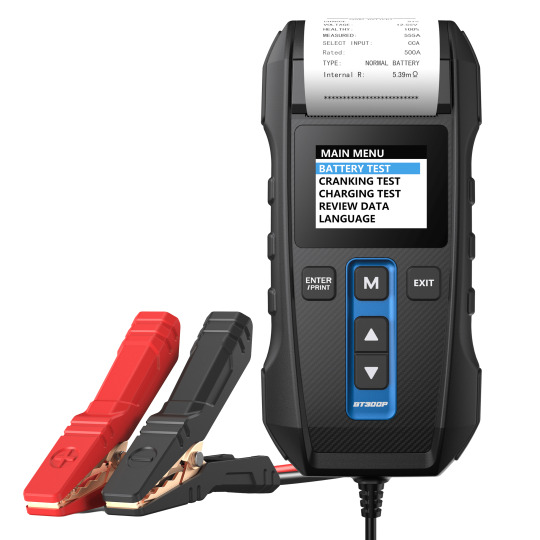
BT600:
BT600 is TOPDON’s newest advanced battery tester for 12V vehicles. With a 3.5-inch color screen and a built-in thermal printer, this tool offers the ultimate solution for accurate, fast, and convenient testing. It allows you to easily view the battery's condition and print test reports in real time. The BT600 adopts cutting-edge conductivity testing technology and includes reverse polarity protection to prevent improper connections. This multifunctional tool can measure the actual Cold Cranking Ampere capacity of the car’s battery, and its state of health, and quickly analyze the starter and charging systems.

TC001:
TOPDON’s TC001 is a portable camera that turns your Android smartphone/tablet or Windows laptop into a powerful thermal imager. Simply download the accompanying app, slot the TC001 in your device’s USB-C port, and unleash thermal technology that formally only belonged to special forces.
Perfect for home inspectors, HVAC technicians, electricians, automotive technicians, and even farmers looking to protect crops and livestock.

TB4000:
The Tornado4000’s smart technology matches the power output to the battery’s needs for safer repair and minimizes unnecessary energy consumption. With this, you can improve the performance and longevity of your batteries. With intelligent microprocessors, this product will charge two times faster than standard chargers, so you can offer timely and efficient services.
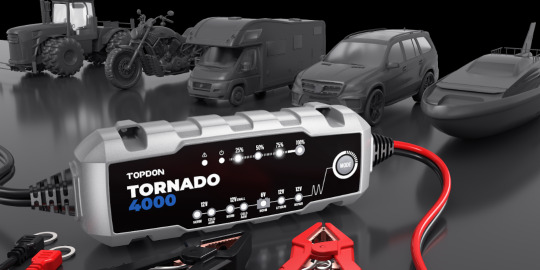
TB8000:
The Tornado4000’s smart technology matches the power output to the battery’s needs for safer repair and minimizes unnecessary energy consumption. With this, you can improve the performance and longevity of your batteries. With intelligent microprocessors, this product will charge two times faster than standard chargers so that you can offer timely and efficient services.

For any Queries contact the mentioned number and website:-
+91 92053 23885
+91 99580 57547
Watch Our Videos for More Details:
Automax Tools India YouTube
Topdon India YouTube
Available at Automax Tools India – Trusted by professionals nationwide!
For more details visit: www.automaxtools.co.in
#car scanner#truck scanner#multi car scanner#muti truck scanner#car and truck scanning tool#OBD#OBD scanner#OEM#OEM scanner#key programming#multi key programming#multi key tool#heavy duty scanner#light commercial scanner#car battery jumper#car batetry scanner#car battery tester#car battery maintainer#Automax#new delhi#india#topdon#jaltest v9#Gscan#Zenith Z5#Gscan Zenith Z5#V2200 plus#JS3000
0 notes
Text
https://automaxtools.co.in/product/g-scan-zenith-z5-car-and-truck-scanner
The Zenith Z5 is an advanced automotive diagnostic tool designed to meet the needs of modern mechanics and technicians. Renowned for its efficiency and reliability, the Zenith Z5 offers a comprehensive range of features that enable precise and efficient vehicle diagnostics.
Key Features of the Zenith Z5:
Extensive Vehicle Coverage: Compatible with a wide range of vehicles, including passenger cars, commercial vehicles, and heavy-duty trucks.
High-Performance Processor: Ensures quick and accurate diagnostics with minimal lag time.
User-Friendly Interface: Intuitive design with a high-definition touchscreen display for easy navigation.
Comprehensive Diagnostics: Capable of performing full-system scans, reading and clearing trouble codes, and accessing live data streams.
Wireless Connectivity: Supports Bluetooth and Wi-Fi for seamless updates and remote diagnostics.
Built-In Battery: Allows portable operation without the need for continuous power supply.
Durable Design: Built to withstand rugged workshop environments with a robust and ergonomic build.
Software Updates: Regular updates ensure the tool stays compatible with the latest vehicle models and systems.
Why Choose the Zenith Z5?
Reliability: Backed by cutting-edge technology and trusted by professionals.
Versatility: Suitable for both small workshops and large-scale automotive service centers.
Cost-Effective: Delivers premium diagnostic capabilities at a competitive price.
With the Zenith Z5, technicians can confidently diagnose and resolve vehicle issues faster, ensuring top-notch service for their customers.
For inquiries or to place an order, contact Automax Tools India, the official distributor of the Zenith Z5.
0 notes
Text
Ancel AD310 Classic Enhanced Universal OBD II Scanner – Your Essential Car Diagnostic Tool
Meta Description: Quickly diagnose and troubleshoot car issues with the Ancel AD310 Classic Enhanced Universal OBD II Scanner. This user-friendly and reliable scanner provides accurate readings to keep your vehicle in top shape. Keeping your car in peak condition is crucial for both safety and performance. The Ancel AD310 Classic Enhanced Universal OBD II Scanner is an invaluable tool that gives…
0 notes
Text
Optimizing Fleet Efficiency: Instrument Cluster Integration in Assembly

Discover the key to enhanced fleet management with our innovative approach to instrument cluster integration in assembly processes. Our solution ensures seamless coordination and real-time monitoring of multiple vehicles, empowering fleet operators with comprehensive insights into performance metrics, diagnostics, and operational data. By incorporating cutting-edge technology into the assembly line, we streamline production while enhancing the functionality and reliability of instrument clusters. Join us in revolutionizing fleet management through precision engineering and advanced instrumentation.
#digital instrument cluster#obd scanner#instrument cluster#Digital gauge meters#cars#electric cars#electric vehicles
0 notes
Text
one of the advantages of never having enough money to own a non-shitty car is that you're used to things going wrong and can help your friends when things go wrong for them too
#rambles.#my gay bff has been texting me because his car gave out on him this morning#and despite being in a more urban area and having a bunch of big-brained science friends i'm like his go-to for the mechanic problems LMAO#he told me what happened and i was like 'MASS AIR FLOW SENSORRRRR' i've had to replace mine twice#but i'm not there with him (lives 3 hrs away) so i can't know for sure. but i finally convinced him to buy an OBD scanner at least
5 notes
·
View notes
Text
i am LAUGHING SO HARD
so luckily nothing happened to my cute lil car after she was maliciously broken into. she was left generally unharmed for the most part
but i bought an obd scanner, scanned my car with it for the 1st time today and immediately got a soft warning light for my catalytic converter
the car thief probably didn't want anything to do with my car not just bc of her high mileage but also bc of her slightly faulty catalyst system LMFAOOOO
#clown horn#saved by the skin of my teeth just bc i neglected ol misfit for a lil while LMAO#man this is amazing. if i had bought my obd scanner any sooner like i wanted to i'd have been screwed#but it got delayed in post due to a million things happening with the usps rn#and i could never be more grateful#now i'm gonna get that issue fixed and drive off into the sunset 💋 they'll keep thinking i have a faulty cat converter#they'll never know#3 cheers for serendipity! now let's hope that i caught this issue sooner rather than later so that the costs aren't wallet-destroying 😬#i have to get my tires rotated on friday. maybe i'll sweet talk the mechanic a lil and he can take a look and give me a good quote 🤞
6 notes
·
View notes
Text

Bluetooth OBD2 Scanner and Car Code Reader for iPhone & Android
The FIXD car scanner and OBD app instantly translates 7000+ engine fault codes into plain English on your phone. Wireless Bluetooth connection. Set up in minutes. No car knowledge needed.
2 notes
·
View notes
Video
youtube
OBD Car Diagnostic Tool | MUCAR CDE900 Pro OBD2 Scanner
#youtube#mucar cde900 pro obd2 scanner#obd car diagnostic tool#car engine diagnostic tool#scan tool#scan tool for car#scan tool review#scan tool diagnostic#car scanner#diagnostic car scanner#diagnostic car tool#mucar#CDE900#obd2 scanner
2 notes
·
View notes
Text
These Are The Essential Tools That Every DIY Mechanic Should Have
Having a basic set of tools for a DIY mechanic is essential. In this article I'll try to give the most comprehensive list I can think of at least for basic tools.
Even if you’re not a seasoned ASE certified mechanic and only do occasional work on your vehicle, there’s still plenty of tools that you should own. You’d be surprised at just how useful some tools are at things around the house and not just for working on a car. In this article I’m going to try to go through a comprehensive list of tools that every DIY mechanic should have. Now, I already know…
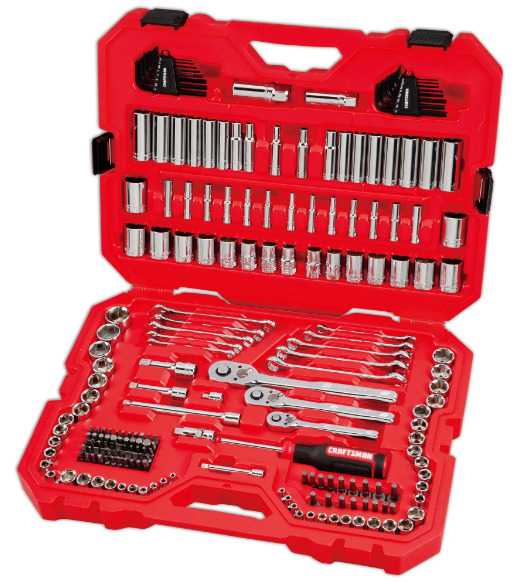
View On WordPress
#Adaptors#Auto Maintenance#automotive#car-maintenance#Creepers#Extension#Jack#Jack Stand#OBD II Scanner#Ratchet#Screwdrivers#Socket#Tools#Torx Bits#vehicle-maintenance#Wrenches
1 note
·
View note
Note
What are the Autobots' opinions on OBD-II Scanners?
Sometimes desperate times call for desperate measures if you don’t have a medic.
#transformers#transformers multiverse#multiverse#earthspark#transformers earthspark#transformers roleplay#tf multiverse newsletter
5 notes
·
View notes
Text
Excited Ramadan Sale At Automax Tools Shop Now
Want to upgrade your garage or at the right place?
After rooming for various distributors around India you came to the right place where you get the original product for the vehicle.
Let me introduce you to Automax Tools an authorised distributor for Gscan and Topdon in India.
The Automax tools have various advanced products that upgrade your garage.
Automax tools also provide 24*7 support services to more than 10,000 happy customers all around India.
For us you are not a customer you all are family.
The list of products Automax tools sell are:-
V2200 plus :
The V2200Plus is a 2-in-1 jump pack and battery tester that takes on the unexpected. Offering up to 35 jumps on a full charge, smart clamps to protect against common safety hazards, and features a 300-lumen LED light. A built-in Bluetooth module supports 12V battery tests by pairing an app with Bluetooth. The V2200Plus is a 2-in-1 jump pack and battery tester that takes on the unexpected. Offering up to 35 jumps on a full charge, smart clamps to protect against common safety hazards, and features a 300-lumen LED light. A built-in Bluetooth module supports 12V battery tests by pairing an app with Bluetooth.

JS3000 :
The JumpSurge3000 is a 3000 Peak Amp jumpstarting tool and power bank for vehicles on and off the road. This device supports vehicles with 12V batteries on up to 9L gas engines and 7L Diesel engines. Capable of 45 jump starts on a single charge, the JumpSurge3000 is a robust and powerful tool capable of bringing a battery “back to life” in only 1 second. It's multiple protection systems and fast charging capability keep you ready for anything, no matter where you go or what you drive.

GScan Zenith Z5:
Introducing our first automotive diagnostic scan tool in the Z series.
In combination with our vast diagnostics software and the world's best industrial tablet, Z5 will give you diagnostic confidence.
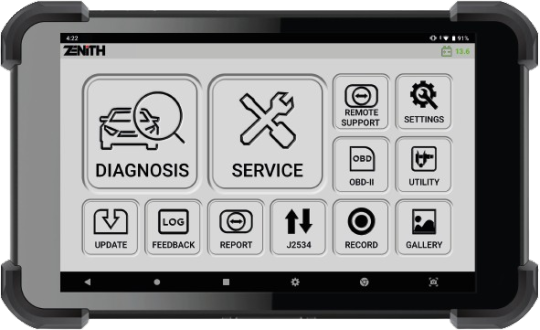
Tornado 90000:
The Tornado90000 is TOPDON's newest cutting-edge smart charger, made for professional and commercial users. This device is suitable for all types of 12V and 24V lead-acid and lithium batteries, with a wide battery capacity range from 5 to 90 amps.
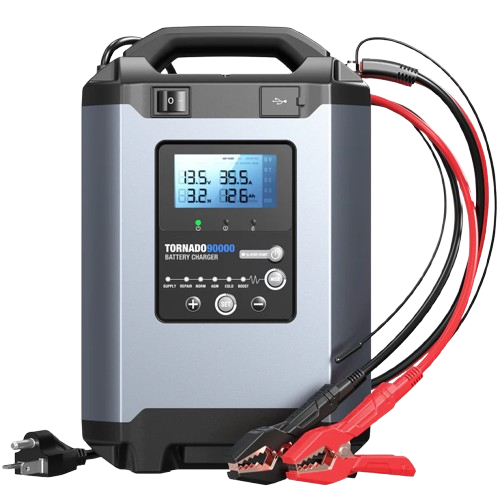
Jaltest V9:
Jaltest V9 is the module of Jaltest Diagnostics multi-brand and multi-system diagnostics tool designed to meet the most demanding workshop needs. It enables carrying out the most advanced diagnostics tasks for the repair and maintenance of commercial vehicles such as trucks, buses, trailers, light commercial vehicles, and pick-up trucks.
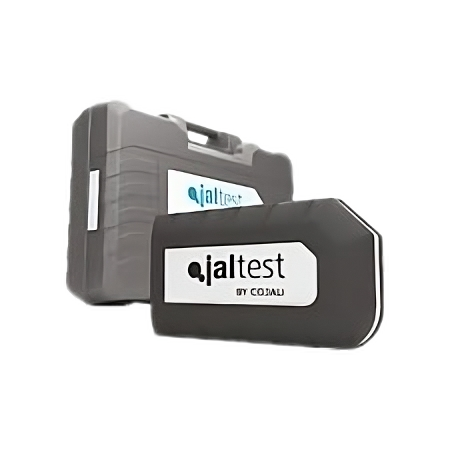
BT200:
TOPDON’s BT200 is an automotive battery tester perfect for new users, with easy plug-and-play operation, and an accurate display of test results. The tests will help users assess whether the battery needs to be replaced.
The tool is suitable for battery testing 12V with up to 2000 Cold Cranking Amps (CCA), cranking testing, and charging testing 12V&24V batteries. It can test Regular Flooded, AGM, GEL, EFB, and VRLA batteries. Test results are based on CCA, DIN, JIS, EN, IEC, GB, SAE, MCA, BCI, and CA Standards.

BT300:
TOPDON®’s BT300P is our newest 12V lead-acid vehicle battery tester with a Built-in Printer. It can test 100 to 2000 Cold Cranking Amps (CCA) batteries
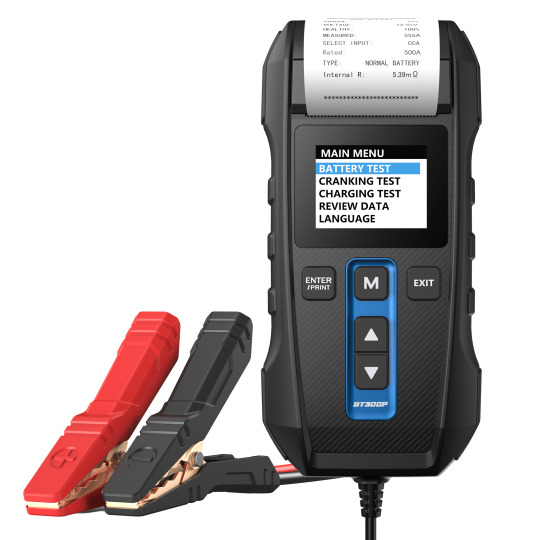
BT600:
BT600 is TOPDON’s newest advanced battery tester for 12V vehicles. With a 3.5-inch color screen and a built-in thermal printer, this tool offers the ultimate solution for accurate, fast, and convenient testing. It allows you to easily view the battery's condition and print test reports in real time. The BT600 adopts cutting-edge conductivity testing technology and includes reverse polarity protection to prevent improper connections. This multifunctional tool can measure the actual Cold Cranking Ampere capacity of the car’s battery, and its state of health, and quickly analyze the starter and charging systems.

TC001:
TOPDON’s TC001 is a portable camera that turns your Android smartphone/tablet or Windows laptop into a powerful thermal imager. Simply download the accompanying app, slot the TC001 in your device’s USB-C port, and unleash thermal technology that formally only belonged to special forces.
Perfect for home inspectors, HVAC technicians, electricians, automotive technicians, and even farmers looking to protect crops and livestock.

TB4000:
The Tornado4000’s smart technology matches the power output to the battery’s needs for safer repair and minimizes unnecessary energy consumption. With this, you can improve the performance and longevity of your batteries. With intelligent microprocessors, this product will charge two times faster than standard chargers, so you can offer timely and efficient services.

TB8000:
The Tornado4000’s smart technology matches the power output to the battery’s needs for safer repair and minimizes unnecessary energy consumption. With this, you can improve the performance and longevity of your batteries. With intelligent microprocessors, this product will charge two times faster than standard chargers, so you can offer timely and efficient services.
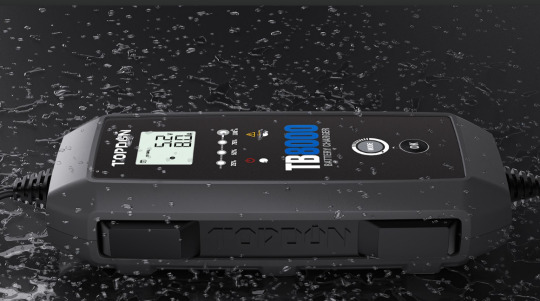
For any Queries contact the mentioned number and website:-
+91 92053 23885
+91 99580 57547
Watch Our Videos for More Details:
Automax Tools India YouTube
Topdon India YouTube
Available at Automax Tools India – Trusted by professionals nationwide!
For more details visit: www.automaxtools.co.in
#car battery scanner#truck battery scanner#multi car scanner#multi truck scanner#car and truck#OBD#OBD scanner#OEM#OEM scanner#key programmer#multi key programmer#multi key tool#heavy duty scanner#light commercial scanner#car battery jumper starter#car battery jumper#car battery tester#car battery charger#car battery maintainer#Automax tools#india#new delhi#AIBA tool#Topdon#Jaltest#Gscan#Zenith Z5#Gscan Zenith Z5#V2200 plus#JS3000 plus
0 notes
Text
7 Incredibly Useful Check Engine Light Tips for Small Businesses
For small businesses that rely on vehicles for daily operations, the check engine light (CEL) can be a frustrating and costly issue. Whether you own a fleet of delivery vans, rideshare vehicles, or service trucks, understanding and addressing the check engine light effectively can save time and money. If you're searching for "car repair near me" or "auto repair near me," here are seven useful tips to keep your business vehicles running smoothly and minimize downtime.
1. Don’t Ignore the Check Engine Light (CEL)
Many small business owners make the mistake of ignoring the check engine light, hoping it will turn off on its own. However, the CEL is an early warning system for potential problems that can escalate if left unaddressed. If your business vehicles are frequently on the road, timely action is essential to avoid expensive repairs and unexpected breakdowns.
2. Use a Diagnostic Tool for Quick Answers
Investing in an OBD-II scanner can help you quickly determine the cause of the CEL. These scanners provide error codes that indicate issues with the engine, transmission, or emissions system. If you’re unfamiliar with these codes, a professional mechanic in Vancouver can interpret them and recommend the necessary repairs.
3. Check for Common Issues First
Before rushing to a repair shop, check for simple causes like a loose or damaged gas cap, which can trigger the CEL. Ensuring your gas cap is tightly sealed can sometimes turn off the warning light without needing further repairs. If the light remains on, it’s time to seek professional assistance.

4. Find a Reliable Auto Repair Shop
Finding a trusted car repair near me or auto repair near me can save your business significant money in the long run. Regular maintenance and prompt repairs prevent minor issues from turning into costly breakdowns. If you're in the Vancouver area, look for a specialized check engine light repair Vancouver service to diagnose and fix the issue efficiently.
5. Keep Up with Regular Maintenance
Routine maintenance, such as oil changes, spark plug replacements, and air filter checks, can prevent the CEL from coming on. Small businesses should establish a maintenance schedule to keep their vehicles in peak condition. Partnering with a reliable mechanic in Vancouver can help keep track of necessary services.
6. Act Fast if the Light is Flashing
A steady CEL typically indicates a less urgent issue, but a flashing check engine light signals a severe problem that requires immediate attention. Driving with a flashing CEL can cause severe engine damage, potentially leading to costly repairs or even complete engine failure.
7. Consider Professional Check Engine Light Repair in Vancouver
If your business is based in Vancouver, seeking a professional check engine light repair Vancouver service can save you time and ensure accurate diagnostics. Many repair shops offer quick turnaround times, helping small businesses minimize vehicle downtime and keep operations running smoothly.
Conclusion
For small businesses that rely on vehicles, the check engine light should never be ignored. Whether it's a minor issue like a loose gas cap or a more serious engine malfunction, addressing the CEL promptly can prevent costly repairs and disruptions. Searching for auto repair near me or mechanic Vancouver can help you find the right professional for the job. Regular maintenance and professional diagnostics are key to keeping your business vehicles in top shape and ensuring long-term reliability.
#Check engine light#check engine light repair vancouver#car repair near me#auto repair near me#Mechanic Vancouver
2 notes
·
View notes
Text
Engine Repair Instruction Full Guide
Engines are the heart of any vehicle, powering everything from your daily commute to long road trips. Knowing how to repair an engine can be a game-changer, whether you're an enthusiast who loves getting your hands dirty or someone looking to save money on mechanic bills. This guide will walk you through the entire process of engine repair, from diagnosing problems to reassembling your engine and ensuring it runs smoothly.

Understanding the Basics of an Engine
Before diving into the repair process, it’s crucial to understand how an engine works. Most vehicles use an internal combustion engine, which combines fuel and air, ignites it, and transforms that explosion into mechanical energy.
Components of an Internal Combustion Engine
The main components include:
Cylinder Block: The engine's core where combustion occurs.
Cylinder Head: Houses the valves and spark plugs.
Pistons: Move up and down to create the force needed to turn the crankshaft.
Crankshaft: Converts the pistons' up-and-down movement into rotational motion.
Camshaft: Controls the opening and closing of the valves.
Valves: Regulate the flow of fuel and air into the engine and exhaust gases out.
How an Engine Works: A Simple Explanation
An engine works by pulling in a mixture of air and fuel, compressing it, igniting it with a spark (in gasoline engines), and then expelling the exhaust gases. This cycle—intake, compression, power, and exhaust—happens in each cylinder and repeats hundreds of times per minute.
Tools and Equipment Needed for Engine Repair

Whether you're performing a basic repair or diving into more complex work, having the right tools is essential.
Essential Tools for Basic Repairs
Socket Set: For removing and tightening bolts.
Wrenches: Different sizes for various engine parts.
Screwdrivers: Flathead and Phillips for screws and clips.
Pliers: For handling wires and small parts.
Torque Wrench: Ensures bolts are tightened to the correct specifications.
Specialized Equipment for Advanced Engine Work
Engine Hoist: For removing the engine from the vehicle.
Cylinder Hone: Prepares cylinders for new piston rings.
Compression Tester: Checks the health of each cylinder.
OBD-II Scanner: Diagnoses engine codes and issues.
Safety Gear and Precautions
Gloves: Protect your hands from cuts and chemicals.
Safety Glasses: Shield your eyes from debris.
Work Boots: Offer protection against heavy parts or tools.
Diagnosing Engine Problems
Accurately diagnosing engine problems is the first step in any repair process. Understanding the symptoms can save time and prevent unnecessary work.
Common Symptoms of Engine Issues

Check Engine Light: Indicates a problem detected by the car's computer.
Strange Noises: Knocking, tapping, or grinding sounds can signal internal damage.
Excessive Smoke: Blue smoke might mean burning oil, while white could suggest a coolant leak.
Loss of Power: Often linked to fuel or air delivery issues.
Step-by-Step Diagnostic Process
Listen and Observe: Note any unusual sounds, smells, or behaviors.
Check Engine Light Codes: Use an OBD-II scanner to retrieve error codes.
Perform Compression Test: Assesses the health of your engine’s cylinders.
Inspect Fluids: Look for contamination or leaks in oil, coolant, and other fluids.
Step-by-Step Guide to Reassembly
Prepare Your Workspace: Ensure that your workspace is clean, organized, and well-lit. Lay out all the parts and tools you'll need in the order of reassembly. Keep the engine manual handy for specific torque specs and sequences.
Install the Crankshaft: Place the crankshaft back into the engine block, ensuring it is seated correctly. Use assembly lube on the main bearings to prevent damage during the initial startup. Torque the main caps to the manufacturer's specifications.
Insert the Pistons: Install the pistons and connecting rods. Be sure to align the piston rings correctly and use a ring compressor to insert the pistons into the cylinder bore. Attach the connecting rods to the crankshaft and torque the rod bolts to spec.
Install the Camshaft and Timing Components: If your engine uses a timing chain or belt, install it according to the timing marks on the camshaft and crankshaft gears. This step is crucial for ensuring the engine's valves open and close at the correct times.
Attach the Cylinder Head: Place the cylinder head gasket on the engine block, followed by the cylinder head. Torque the head bolts in the correct sequence and to the proper specifications. This ensures a good seal and prevents head gasket failure.
Install Valves, Lifters, and Pushrods: If applicable, install the engine's valves, lifters, and pushrods. Make sure they are properly aligned and that the lifters are seated correctly in their bores.
Reassemble the Valve Train: Install the rocker arms and adjust the valve lash according to the engine manual. Proper valve lash is critical for engine performance and longevity.
Reattach External Components: Begin reattaching external components like the water pump, oil pump, timing cover, oil pan, and intake manifold. Replace any gaskets and seals during this process to prevent leaks.
Reconnect the Fuel and Ignition Systems: Reinstall the fuel injectors, spark plugs, and ignition wires. Ensure all electrical connections are secure and properly routed to avoid short circuits or malfunctions.
Final Checks: Before moving on, double-check all connections, bolts, and components. Make sure nothing is left loose or unconnected.
Applying Proper Torques and Specifications
Every engine has specific torque settings for each bolt. Over-tightening can strip threads or warp components, while under-tightening can lead to leaks or parts coming loose. Use a torque wrench and follow the manufacturer's specifications closely.
Double-Checking Work for Mistakes

It's easy to miss a step or make a mistake during reassembly. Double-check your work:
Ensure all components are installed in the correct order.
Verify all bolts are torqued to spec.
Check for any leftover parts or tools in the engine bay.
Testing the Repaired Engine
With the engine reassembled, the next step is testing it to ensure everything is functioning properly.
Preparing for Initial Startup
Before starting the engine, perform a few preparatory checks:
Prime the oil system: This can be done by cranking the engine with the fuel system disabled until oil pressure is achieved.
Fill the engine with fresh oil and coolant.
Double-check all electrical connections and fuel lines.
Checking for Leaks and Unusual Noises

Once you start the engine, pay close attention to any unusual noises or leaks:
Oil Leaks: Check around the oil pan, valve covers, and front and rear seals.
Coolant Leaks: Inspect the radiator, hoses, and water pump area.
Unusual Noises: Listen for knocking, tapping, or whining sounds, which could indicate an issue with the timing components or internal parts.
Fine-Tuning and Adjusting the Engine
After the initial startup, the engine may require some adjustments:
Timing Adjustments: Use a timing light to set the ignition timing.
Idle Speed: Adjust the idle speed according to the manufacturer’s specifications.
Fuel Mixture: On carbureted engines, you may need to adjust the air-fuel mixture for optimal performance.
Common Engine Repair Mistakes to Avoid
Engine repair is complex, and mistakes can be costly. Here are some common errors to watch out for:
Misalignments and Incorrect Torques
Misaligned timing components can lead to poor engine performance or damage.
Incorrectly torqued bolts can cause leaks, parts failure, or engine damage.
Overlooking Small Parts and Connections
Small parts like washers, clips, or gaskets are easy to overlook but crucial for preventing leaks and ensuring proper function.
Electrical connections: Double-check that all sensors and connectors are properly seated.
Skipping Diagnostic Steps
Skipping steps in the diagnostic process can lead to unnecessary repairs or missed issues. Always perform thorough diagnostics before and after repairs.
Maintaining Your Engine After Repair
Proper maintenance is key to ensuring the longevity of your newly repaired engine.
Importance of Regular Maintenance
Regular maintenance, such as oil changes, air filter replacements, and coolant checks, is essential to keep your engine running smoothly and prevent future problems.

Tips for Extending Engine Life
Use high-quality oil and filters.
Avoid hard driving until the engine is fully warmed up.
Regularly check and maintain fluid levels.
When to Seek Professional Help
While DIY repairs can save money, some issues are best left to professionals, especially if you encounter complex problems or lack the necessary tools and expertise.
Dealing with Advanced Engine Repairs
Some engine repairs are too complex for the average DIYer. Here's when to consider professional help:
Understanding When It’s Beyond DIY
Extensive internal damage: Cracked blocks or severely worn bearings usually require professional expertise.
Advanced electrical issues: Problems with engine management systems often need specialized diagnostic tools and knowledge.
Overview of Complex Repairs: Timing Belt, Engine Rebuilds
Timing Belt Replacement: Involves precise alignment of engine components and is critical for preventing engine damage.
Engine Rebuilds: This is a time-consuming and complex task that often requires professional machining and specialized tools.
Working with a Professional Mechanic
When the repair is beyond your capabilities, working with a professional mechanic ensures that the job is done correctly and safely. They have the tools, experience, and resources to handle complex engine repairs.
Cost Considerations in Engine Repair
Engine repair costs can vary widely depending on the scope of work, parts required, and whether you do it yourself or hire a professional.
Estimating Costs for DIY vs Professional Repair
DIY Repairs: Typically cost less but require an investment in tools and time.
Professional Repairs: Can be expensive but come with the assurance of experience and often a warranty.
Budgeting for Tools, Parts, and Time
Consider the cost of any special tools or equipment you might need, as well as the cost of replacement parts. Factor in the time required, especially if the vehicle is your daily driver.
Understanding the Cost of Mistakes
Mistakes can be costly. Stripping a bolt, breaking a part, or incorrect assembly can lead to additional expenses. Always weigh the risks before starting a major repair.
Conclusion
Recap of Key Points
Engine repair is a rewarding but challenging task that requires careful planning, the right tools, and attention to detail. Whether you’re fixing a minor issue or performing a complete rebuild, following the correct procedures is crucial for success.
Encouragement for DIY Enthusiasts
For those who love working on their vehicles, engine repair can be a satisfying and cost-effective way to maintain your car. With patience and persistence, even complex repairs can be tackled with confidence.
Final Thoughts on Engine Repair
Always approach engine repair with a clear plan and the right resources. Don’t hesitate to seek professional help when needed, and remember that regular maintenance is the best way to avoid major repairs.
FAQs
How do I know if my engine needs repair?
Common signs include unusual noises, excessive smoke, loss of power, and a check engine light. Regular diagnostics can help catch issues early.
Can I repair my engine without professional help?
Basic repairs like replacing gaskets or sensors can often be done at home with the right tools. However, more complex tasks like engine rebuilds may require professional expertise.
What are the signs of a failing engine?
Signs include knocking noises, excessive oil consumption, smoke from the exhaust, and persistent overheating.
How long does it take to repair an engine?
The time required varies greatly depending on the complexity of the repair. Simple repairs might take a few hours, while a full rebuild could take several days or longer.
2 notes
·
View notes
Text
Introducing Our Specialized OBD Scanner for Bikes
Attention Vehicle Manufacturers: Are you seeking a game-changing solution to enhance your bike production processes? Look no further! Our cutting-edge OBD Manufacturing company introduces a specialized OBD scanner meticulously crafted for bike manufacturers, both in traditional and EV sectors.
Unlock unparalleled efficiency and precision in diagnostics and maintenance with our advanced OBD scanner for bikes. Tailored to meet the diverse needs of the bike manufacturing industry, our scanner seamlessly integrates into your production line, providing real-time insights and optimizing quality control.
Whether you specialize in conventional bikes or cutting-edge electric vehicles, our OBD scanner is your indispensable partner. Gain comprehensive data on performance metrics, emissions, and health diagnostics, enabling you to elevate production standards and exceed customer expectations.
Ready to revolutionize your bike manufacturing process? Embrace the future of vehicle production with our specialized OBD scanner for bikes. Contact us today to learn more about how we can drive your success!

0 notes
Text
From Engine to Electronics: Proper Diagnostic Techniques for Resolving Maserati Problems

Maserati, the epitome of Italian luxury and performance, is renowned for its stylish design and high-performance capabilities. However, like any high-end vehicle, Maserati can encounter a range of issues, from engine troubles to electronic malfunctions. Proper diagnostics is crucial in maintaining the health and performance of these sophisticated machines. This article will guide you through the common problems Maserati face and the proper diagnostic techniques to resolve them.
Common Maserati Problems
1. Engine Issues
Maserati engines are marvels of engineering, but they can develop problems over time. Common engine issues include:
Misfires and Rough Idling: This can be caused by faulty spark plugs, ignition coils, or fuel injectors.
Overheating: Often due to a malfunctioning cooling system, such as a failed water pump or a clogged radiator.
Oil Leaks: These can originate from various seals and gaskets, leading to low oil levels and potential engine damage.
2. Transmission Problems
Maserati transmissions are designed for performance but can experience:
Slipping Gears: This could indicate worn-out clutch plates or issues with the transmission fluid.
Delayed Shifts: Often due to problems with the transmission control module or low fluid levels.
3. Electrical and Electronic Failures
Modern Maseratis are equipped with advanced electronics that can sometimes fail, including:
Dashboard Warning Lights: These can indicate issues ranging from simple sensor failures to serious engine problems.
Infotainment System Glitches: Problems with the touch screen, navigation, or audio system are not uncommon.
Diagnostic Techniques
1. OBD-II Scanner
The On-Board Diagnostics II (OBD-II) scanner is an essential tool for diagnosing Maserati problems. It can read error codes from the car's computer, providing insight into various issues.
How to Use: Connect the OBD-II scanner to the port located under the dashboard. Turn on the ignition and follow the scanner’s instructions to retrieve the error codes.
Interpreting Codes: Each code corresponds to a specific problem. For example, P0300 indicates a random/multiple cylinder misfire, while P0128 points to a coolant thermostat issue.
2. Visual Inspection
A thorough visual inspection can reveal obvious issues such as leaks, damaged components, or worn-out parts.
Engine Bay: Check for oil leaks, loose connections, and the condition of belts and hoses.
Undercarriage: Inspect for fluid leaks and damage to the exhaust system.
Electrical Connections: Look for corroded or loose battery terminals and wiring issues.
3. Multimeter Testing
A multimeter is useful for diagnosing electrical issues in a Maserati.
Battery Voltage: Measure the voltage across the battery terminals. A healthy battery should read around 12.6 volts when the car is off and around 14 volts when running.
Sensor Checks: Test various sensors, such as the oxygen sensor or mass airflow sensor, to ensure they are functioning correctly.
4. Compression Test
A compression test helps diagnose internal engine problems such as worn piston rings or valves.
Procedure: Remove the spark plugs and insert a compression gauge into each cylinder. Crank the engine and note the pressure readings. Low or uneven readings indicate internal engine issues.
5. Professional Diagnostic Tools
Maserati dealerships and specialized repair shops use advanced diagnostic tools that can access proprietary systems and provide more detailed information.
SD2/SD3 Diagnostic Systems: These are specialized tools used by Maserati technicians to diagnose and program vehicle systems accurately.
Diagnostic Software: Tools like Xentry or PIWIS can interface with Maserati's electronic systems for comprehensive diagnostics.
Addressing Common Issues
1. Engine Repairs
Misfires and Rough Idling: Replace faulty spark plugs, ignition coils, or fuel injectors. Regular maintenance and using high-quality fuel can prevent these issues.
Overheating: Ensure the cooling system is functioning correctly by checking the water pump, radiator, and thermostat. Flushing the coolant system periodically is also recommended.
Oil Leaks: Identify the source of the leak and replace the necessary seals or gaskets. Regularly check oil levels and change the oil according to the manufacturer's recommendations.
2. Transmission Solutions
Slipping Gears: Inspect and replace worn clutch plates and ensure the transmission fluid is at the correct level. Consider a fluid change if necessary.
Delayed Shifts: Diagnose and repair issues with the transmission control module or solenoids. Regular transmission servicing can prevent many of these problems.
3. Electrical Fixes
Dashboard Warning Lights: Use an OBD-II scanner to identify and address the underlying issue. Reset the warning lights after repairs are completed.
Infotainment System Glitches: Perform software updates and check for any loose connections or faulty components. In some cases, a complete system reset may be required.
Conclusion
Proper diagnostics are essential for maintaining the performance and reliability of your Maserati. By using the right tools and techniques, you can identify and resolve issues promptly, ensuring your luxury car continues to deliver the driving experience it was designed for. Regular maintenance and timely repairs are key to keeping your Maserati in top condition, from the engine to the sophisticated electronics.
#maserati car#maserati car diagnosis#maserati service center#maserati car maintenance#maserati car mechanic
2 notes
·
View notes
Text

OBD2 Bluetooth Scanner with Vehicle Diagnostics App for iOS & Android
The newly upgraded V011 OBD2 Scanner supports most car makes and models, making it one of the most versatile diagnostic tools on the market. It is compatible with many brands, including Toyota, Honda, Chevrolet, Ford, Mercedes-Benz, Jeep, BMW, Porsche, Subaru, Nissan, Cadillac, Volkswagen, and Lexus.
0 notes